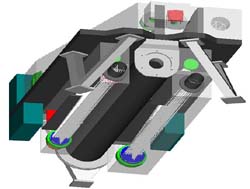
Under the auspices of the French Space Agency (CNES), a panel meeting was held from 5 to 8 June in Toulouse to evaluate the A-phase development of SMESE (Small Explorer for the Study of Solar Eruptions), a Chinese-French micro-satellite mission to make explorations in the field of solar physics. Present at the meeting were some 70 experts to attend the meeting, including a 15-membered delegation dispatched by the Chinese side.
The participants delivered a total of 33 reports in seven categories, including tasks & management, scientific targets and requirements, instruments, payload interfaces, the launch pad for the satellites, the land-based platform, and plan schemes for further development. In a special session, the appraising committee made enquiries on the development of the Chinese side.
The scientific objectives of SMESE are the study of coronal mass ejections and flares. Its payload consists of three instrument packages: LYOT, DESIR and HEBS. LYOT is com-posed of a Ly-α (121.6 nm) coronagraph, a Ly-α disk imager and a far UV disk imager. DESIR is an infrared telescope working at 35μm and 150μm. HEBS is a high energy burst spectrometer working in X-rays and γ-rays covering the 10keV to 600 MeV range. SMESE will be launched around 2011, providing a unique opportunity of detecting and understanding eruptions at the maximum activity phase of the solar cycle in a wide range of energies.
To make preparations for the evaluation, a team of French scientists for the SMESE came to the CAS Center of Space Science and Application Research in late April for the seventh key point of the project (SMESE-KP7).
As one of the international cooperative initiatives preset by the China's National Space Administration during the period of the 11th Five-year Plan for the national development (2006-2010), SMESE has won the State support and now everything is proceeding in a burgeoning, smooth and orderly way for its enforcement.
Since its inauguration more than one year ago, the two sides have held bilateral meetings for more than a score of times. The convention of the current meeting means the whole project has finished its A-phased stage of initial demands and well-prepared for its next stage's work. The Chinese partners of the project include the Purple Mountain Observatory under the CAS, the CAS Center for Space Science & Applied Research, the CAS Institute for Remote-sensing Application, the National Astronomic Observatories, and Nanjing University.







